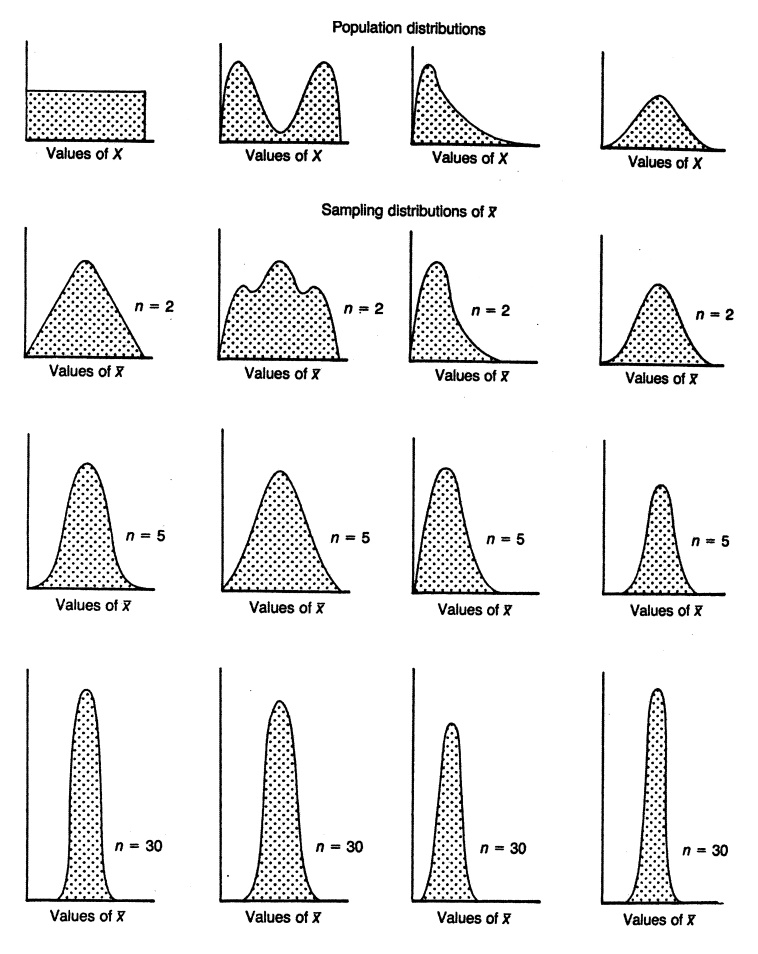The Central Limit Theorem
| Home | | Advanced Mathematics |Chapter: Biostatistics for the Health Sciences: Sampling Distributions for Means
In all cases, by the time n = 30, the distribution in very symmetric and the variance continually decreases as we noticed for the home run data in the previous section.
THE CENTRAL LIMIT THEOREM
Section 7.1 illustrated that as we average sample
values (regardless of the shape of the distribution for the observations for
the parent population), the sample average has a distribution that becomes
more and more like the shape of a normal distribution (i.e., symmetric and
unimodal) as the sample size increases. Figure 7.4, taken from Kuzma (1998),
shows how the distribution of the sample mean changes as the sample size n increases from 1 to 2 to 5 and finally
to 30 for a uni-form distribution, a bimodal distribution, a skewed
distribution, and a symmetric distribution.
In all cases, by the time n = 30, the distribution in very symmetric and the variance
continually decreases as we noticed for the home run data in the previous
section. So, the figure gives you an idea of how the convergence depends on
both the sample size n and the shape
of the population distribution function.
What we see from the figure is remarkable.
Regardless of the shape of the popu-lation distribution, the sample averages
will have a nearly symmetric distribution approximating the normal distribution
in shape as the sample size gets large! This is

Figure 7.4. The effect of shape of population distribution and sample size on the distribution of means of random samples. (Source: Kuzma, J. W. Basic Statistics for the Health Sciences. Mountain View, California: Mayfield Publishing Company, 1984, Figure 7.3, p. 82.)
Suppose we have taken a random sample of size n from a population (generally, n needs to be at least 25 for the
approximation to be accurate, but sometimes larger samples sizes are needed and occasionally, for symmetric
populations, you can do fine with only 5 to 10 samples). We assume the
population has a mean μ and a standard deviation σ. We then can assert the following:
1. The distribution of sample
means ![]() is
approximately a normal distribution regardless of the population distribution.
If the population distribution is nor-mal, then the distribution for
is
approximately a normal distribution regardless of the population distribution.
If the population distribution is nor-mal, then the distribution for ![]() is exactly normal.
is exactly normal.
2. The mean for the distribution
of sample means is equal to the mean of the population distribution (i.e., μ![]() = μ where μ
= μ where μ![]() denotes the mean of the distri-bution of the sample means). This
statement signifies that the sample mean is an unbiased estimate of the
population mean.
denotes the mean of the distri-bution of the sample means). This
statement signifies that the sample mean is an unbiased estimate of the
population mean.
3. The standard deviation of the
distribution of sample means is equal to the standard deviation of the
population divided by the square root of the sample size [i.e., σ![]() = (σ/n), where σ
= (σ/n), where σ![]() is the standard deviation of the distribution of
sample means based on n
observations]. We call σ
is the standard deviation of the distribution of
sample means based on n
observations]. We call σ![]() the standard error of the mean.
the standard error of the mean.
Property 1 is actually the central limit theorem.
Properties 2 and 3 hold for any sam-ple size n when the population has a finite mean and variance.
Related Topics
